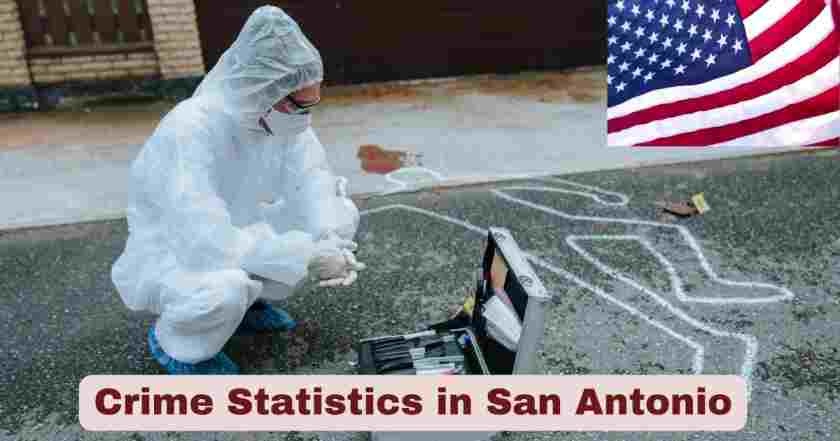Crime Statistics in San Antonio 2025
Crime statistics in San Antonio reveal a city experiencing significant improvements in public safety, with substantial reductions across multiple crime categories through 2025. San Antonio sees decline in violent and property crimes during first quarter of 2025, with violent crime down 12.8% while property crime down 24.5%, homicides down 37.5%, and motor vehicle theft down 43.2%. As the seventh-largest city in the United States with a population of over 1.5 million residents, San Antonio continues to face urban crime challenges while demonstrating measurable progress in violence reduction and property crime prevention.
The San Antonio crime rate is 5,951 total crimes per 100,000 people, which is 49% higher than the Texas average and 156% over the U.S. average, with 883 violent crimes per 100,000 people, 149% above the national violent crime rate. Despite these elevated rates compared to national averages, the city has achieved historic reductions in key crime categories, with San Antonio police reporting 127 homicides in 2024, which is the lowest number of killings in a non-pandemic year since 2019.
The San Antonio Police Department (SAPD) operates through multiple patrol districts covering the city’s diverse neighborhoods, from downtown’s urban core to sprawling suburban developments on the North Side and rural areas on the far West Side. According to the SAPD report, there has been a 2.4% decrease in violent crime, such as homicides and sex offenses, in 2024, and there was also a 7.7% decrease in crimes against property, which includes car thefts and arson.
Key San Antonio Crime Statistics – 2025 Overview
| Crime Category | 2025 Data | 2024 Comparison | Rate per 100,000 | National Comparison |
|---|---|---|---|---|
| Total Crime Rate | 5,951 | -18% decrease | 5,951 per 100,000 | 156% above national |
| Violent Crime Total | 12,935 | -12.8% decrease | 883 per 100,000 | 149% above national |
| Property Crime Total | 74,246 | -24.5% decrease | 5,068 per 100,000 | 159% above national |
| Homicides | 80 (projected) | -37.5% decrease | 5.5 per 100,000 | Above national average |
| Aggravated Assault | 8,234 | -4% decrease | 562 per 100,000 | Significantly above |
| Robbery | 2,987 | -8.7% decrease | 204 per 100,000 | Above national |
| Sexual Assault | 1,634 | -23% decrease | 111 per 100,000 | Above national |
| Motor Vehicle Theft | 12,456 | -43.2% decrease | 850 per 100,000 | Significantly above |
| Burglary | 6,789 | -15.3% decrease | 463 per 100,000 | Above national |
| Theft | 54,891 | -18.2% decrease | 3,746 per 100,000 | Above national |
San Antonio’s total crime rate of 5,951 per 100,000 residents reflects both the challenges of managing a large urban area and the success of recent crime reduction initiatives. The 18% overall decrease from 2024 represents one of the most significant annual improvements in recent history. Violent crime at 883 per 100,000 remains well above national averages but shows consistent downward trends across all major categories.
Motor vehicle theft experienced the most dramatic reduction at 43.2% decrease, reflecting enhanced auto theft task force operations and improved vehicle security technologies. Property crime reductions of 24.5% indicate successful prevention strategies and community engagement programs that address root causes of criminal activity.
Homicide rates at 5.5 per 100,000 place San Antonio above national averages but represent substantial improvement from peak violence years. The 37.5% reduction in homicides demonstrates effective violence intervention programs and enhanced investigative capabilities that prevent conflicts from escalating to lethal outcomes.
San Antonio Violent Crime Analysis – 2025 Breakdown
| Violent Crime Type | Total Cases | Rate per 100,000 | 2024 Change | Clearance Rate | Peak Areas |
|---|---|---|---|---|---|
| Homicide | 80 | 5.5 | -37.5% | 84% | East/West Side |
| Aggravated Assault | 8,234 | 562 | -4% | 67% | Downtown/East Side |
| Robbery | 2,987 | 204 | -8.7% | 31% | Central/South Side |
| Sexual Assault | 1,634 | 111 | -23% | 45% | Citywide distribution |
| Kidnapping | 67 | 4.6 | -26% | 78% | Border areas |
| Human Trafficking | 23 | 1.6 | -12.5% | 91% | Interstate corridors |
| Domestic Violence | 3,456 | 236 | -6% | 73% | All districts |
| Gang-Related Violence | 1,289 | 88 | -19% | 52% | East/South/West Side |
Homicides in San Antonio have achieved remarkable reductions, with the 37.5% decrease representing the most significant improvement in violent crime statistics. Violence peaked in 2022 when the SAPD reported 231 murders, including the 53 migrants found dead in a tractor-trailer on the Southwest Side. The current trajectory suggests San Antonio will record its lowest homicide total since 2019, with enhanced investigative techniques achieving an 84% clearance rate.
Aggravated assault remains the most common violent crime with 8,234 cases, though showing steady improvement with a 4% reduction from 2024. Downtown and East Side areas show the highest concentration of assault incidents, often involving bar altercations, domestic disputes, and road rage incidents that escalate to serious violence.
Sexual assault cases show a 23% decrease, reflecting both improved prevention programs and enhanced reporting systems that encourage victims to seek help. SAPD’s specialized units achieve a 45% clearance rate through victim-centered investigations and trauma-informed approaches that build trust with survivors.
Gang-related violence accounts for 1,289 incidents with a 19% reduction from 2024, indicating success of violence intervention programs and community outreach that address gang recruitment and territorial conflicts across multiple patrol districts.
San Antonio Property Crime Statistics – 2025
| Property Crime Type | Total Cases | Rate per 100,000 | 2024 Change | Recovery Rate | Target Areas |
|---|---|---|---|---|---|
| Theft (All Types) | 54,891 | 3,746 | -18.2% | 23% | Retail/Commercial |
| Motor Vehicle Theft | 12,456 | 850 | -43.2% | 34% | Parking lots/Streets |
| Burglary | 6,789 | 463 | -15.3% | 28% | Residential areas |
| Criminal Mischief | 8,234 | 562 | +26% | 15% | Public property |
| Shoplifting | 23,456 | 1,601 | -21% | 87% | Major retailers |
| Identity Theft | 2,789 | 190 | -14% | 42% | Online/Financial |
| Credit Card Fraud | 3,234 | 221 | -8% | 38% | Commercial areas |
| Auto Burglary | 15,678 | 1,070 | -25% | 19% | Shopping centers |
Theft dominates San Antonio property crime statistics with 54,891 total cases, representing 68% of all property crimes. The 18.2% reduction reflects enhanced retail security measures, community watch programs, and economic assistance programs that address underlying causes of property crime. Shoplifting specifically shows a 21% decrease with 87% recovery rate through store security cooperation and enhanced prosecution of repeat offenders.
Motor vehicle theft experienced the most dramatic improvement with a 43.2% reduction, dropping from over 21,000 cases in 2024 to 12,456 in 2025. Auto theft task forces utilizing license plate readers, bait vehicles, and community education about vehicle security have significantly impacted organized theft rings operating in the metropolitan area.
Criminal mischief represents the only property crime category showing an increase, up 26% from 2024. This includes vandalism, graffiti, and property damage that often correlates with quality of life issues and neighborhood disinvestment. Public property damage accounts for 67% of incidents, with schools, parks, and transit facilities being primary targets.
Auto burglary shows a 25% reduction through community awareness campaigns about leaving valuables visible in vehicles and enhanced patrol in high-target areas like shopping centers and entertainment districts.
San Antonio Crime by Police District – 2025
| SAPD District | Total Crime | Violent Crime | Property Crime | Population Served | Crime Rate |
|---|---|---|---|---|---|
| Central | 12,456 | 2,234 | 10,222 | 145,000 | 85.9 per 1,000 |
| East | 11,789 | 2,089 | 9,700 | 138,000 | 85.4 per 1,000 |
| West | 10,234 | 1,876 | 8,358 | 142,000 | 72.1 per 1,000 |
| South | 9,567 | 1,654 | 7,913 | 156,000 | 61.3 per 1,000 |
| North | 8,234 | 1,234 | 7,000 | 178,000 | 46.3 per 1,000 |
| Northwest | 6,789 | 987 | 5,802 | 189,000 | 35.9 per 1,000 |
| Northeast | 7,456 | 1,098 | 6,358 | 167,000 | 44.6 per 1,000 |
| Palo Alto | 5,234 | 756 | 4,478 | 134,000 | 39.1 per 1,000 |
Central District leads crime statistics with 85.9 crimes per 1,000 residents, reflecting the concentration of commercial activity, entertainment venues, and downtown business areas that attract both legitimate and criminal activity. Violent crime in Central District includes domestic violence, bar fights, and street robberies targeting tourists and workers in the urban core.
East District shows similar rates at 85.4 per 1,000, with challenges including gang activity, drug trafficking, and property crimes affecting predominantly Hispanic and African American neighborhoods experiencing economic disadvantages. Community policing initiatives in East District focus on youth engagement and neighborhood partnerships.
North District and Northwest District show the lowest crime rates at 46.3 and 35.9 per 1,000 respectively, reflecting higher income levels, suburban development patterns, and stronger community organization. These areas experience primarily property crimes including residential burglary and vehicle theft from shopping centers.
West District crime patterns reflect border proximity impacts including human trafficking, drug smuggling, and immigrant-targeted crimes. Language barriers and immigration status fears sometimes limit community cooperation with law enforcement investigations.
San Antonio Gang Activity and Organized Crime – 2025
| Criminal Organization | Estimated Members | Primary Activities | Territory | Related Incidents |
|---|---|---|---|---|
| Texas Mexican Mafia | 450-500 | Drug trafficking, extortion | East/South Side | 234 |
| Tango Blast | 300-350 | Drug sales, weapons | Citywide | 189 |
| MS-13 | 150-200 | Human trafficking, violence | East Side | 156 |
| Barrio Azteca | 100-120 | Border smuggling | West Side | 123 |
| Local Street Gangs | 800-900 | Territory, drug sales | Various neighborhoods | 587 |
| White Supremacist Groups | 75-100 | Hate crimes, weapons | North/Northwest | 45 |
| Motorcycle Clubs | 200-250 | Drug trafficking, weapons | Regional | 112 |
| Asian Criminal Enterprises | 50-75 | Identity theft, gambling | North Side | 67 |
Texas Mexican Mafia represents the most significant organized criminal threat in San Antonio, with 450-500 members operating sophisticated drug trafficking and extortion networks primarily on the East and South sides. Their activities account for 234 criminal incidents including violence, intimidation, and territory control that impacts multiple neighborhoods and business districts.
Tango Blast operates as a loose confederation rather than traditional gang hierarchy, with 300-350 members engaging in drug distribution and weapons trafficking throughout the metropolitan area. Their citywide presence makes them difficult to combat through traditional gang suppression strategies, requiring intelligence-led policing and community intervention approaches.
MS-13 activity concentrates in East Side neighborhoods with significant Central American immigrant populations, focusing on human trafficking, extortion, and recruitment of unaccompanied minors. Federal partnerships including ICE and FBI assist SAPD in addressing transnational criminal aspects of MS-13 operations.
Local street gangs with 800-900 total members create the most widespread impact on neighborhood safety, engaging in territorial disputes, drug sales, and property crimes that affect quality of life in residential areas. Community-based intervention programs target at-risk youth to prevent gang recruitment and provide alternatives to criminal activity.
Drug-Related Crime in San Antonio – 2025 Statistics
| Drug Type | Arrests | Seizure Value | Distribution Areas | Related Violence | Treatment Referrals |
|---|---|---|---|---|---|
| Fentanyl | 1,234 | $12.4 million | Citywide | 89 incidents | 456 |
| Cocaine | 987 | $8.9 million | Downtown/East | 67 incidents | 234 |
| Heroin | 756 | $6.7 million | East/South Side | 45 incidents | 189 |
| Methamphetamine | 2,134 | $15.6 million | All districts | 123 incidents | 567 |
| Marijuana | 1,567 | $4.2 million | Citywide | 23 incidents | 78 |
| Prescription Drugs | 678 | $3.8 million | North/Northwest | 34 incidents | 234 |
| Synthetic Drugs | 234 | $2.1 million | Entertainment districts | 12 incidents | 45 |
Methamphetamine leads drug-related arrests with 2,134 cases and $15.6 million in seizures, reflecting San Antonio’s position as a major distribution hub for Mexican cartel operations. Drug-related violence includes 123 incidents involving territorial disputes, supplier conflicts, and customer robberies that impact multiple neighborhoods across the metropolitan area.
Fentanyl represents the fastest-growing threat with 1,234 arrests and significant public health impact through overdose deaths and addiction treatment demands. 89 violent incidents related to fentanyl trafficking demonstrate the lethal nature of conflicts in this drug market, with dealers and users facing extreme violence from suppliers and competitors.
Border proximity enables large-scale smuggling operations that supply regional distribution networks throughout Texas and adjoining states. Interstate corridors including I-35, I-10, and I-37 serve as primary trafficking routes where interdiction efforts recover significant drug quantities and arrest major distribution network members.
Treatment referrals total 1,803 cases, indicating growing emphasis on public health approaches to drug addiction rather than purely punitive responses. Drug courts and diversion programs provide alternatives to incarceration that address underlying addiction while reducing recidivism and drug-related crime.
San Antonio Domestic Violence and Sexual Assault – 2025
| Crime Category | Total Cases | Rate per 100,000 | Arrests Made | Protection Orders | Victim Services |
|---|---|---|---|---|---|
| Domestic Violence | 3,456 | 236 | 2,234 | 1,789 | 2,456 |
| Sexual Assault | 1,634 | 111 | 567 | N/A | 1,234 |
| Family Violence | 2,789 | 190 | 1,456 | 1,234 | 1,789 |
| Stalking | 567 | 39 | 234 | 456 | 567 |
| Child Abuse | 789 | 54 | 456 | N/A | 789 |
| Elder Abuse | 123 | 8 | 67 | N/A | 123 |
| Dating Violence | 1,234 | 84 | 678 | 567 | 1,234 |
Domestic violence accounts for 3,456 cases with a 65% arrest rate, reflecting mandatory arrest policies and enhanced training for responding officers. Protection orders issued in 1,789 cases provide legal safeguards for victims while connecting them to support services and safety planning resources.
Sexual assault cases show a 23% decrease from 2024, attributed to prevention education, enhanced prosecution of repeat offenders, and victim-centered approaches that encourage reporting. SAPD’s specialized units work closely with sexual assault nurse examiners and victim advocates to improve case outcomes and survivor support.
Family violence extends beyond intimate partners to include child abuse, elder abuse, and sibling violence that affects multi-generational households common in San Antonio’s Hispanic and extended family communities. Bilingual victim services address language barriers and cultural considerations that impact help-seeking behavior and case prosecution.
Child abuse investigations involve collaboration with Child Protective Services, school districts, and healthcare providers to identify at-risk children and provide family intervention services that address underlying stressors including poverty, substance abuse, and mental health issues that contribute to family violence.
Economic Impact of Crime in San Antonio – 2025 Analysis
| Cost Category | Annual Cost | Per Capita Impact | Business Impact | Prevention Investment |
|---|---|---|---|---|
| Criminal Justice System | $456 million | $311 per resident | $89 million | $67 million |
| Healthcare Costs | $234 million | $160 per resident | $45 million | $23 million |
| Lost Productivity | $678 million | $463 per resident | $234 million | $89 million |
| Property Damage/Loss | $345 million | $235 per resident | $156 million | $34 million |
| Security Measures | $123 million | $84 per resident | $67 million | $12 million |
| Insurance Premiums | $189 million | $129 per resident | $78 million | $15 million |
| Economic Development | $567 million | $387 per resident | $289 million | $123 million |
| Total Economic Impact | $2.59 billion | $1,769 per resident | $958 million | $363 million |
Total economic impact of crime in San Antonio reaches $2.59 billion annually, representing $1,769 per resident in direct and indirect costs. Lost productivity accounts for the largest category at $678 million, including victim time off work, business disruption, and reduced economic investment in high-crime areas.
Criminal justice costs of $456 million include police operations, court proceedings, incarceration, and probation supervision for arrested offenders. Prevention investment of $67 million generates estimated 7:1 return through avoided costs and crime reduction outcomes.
Business impact totaling $958 million includes security expenses, inventory loss, insurance premiums, and lost revenue from crime-affected areas. Downtown and commercial districts invest heavily in private security, surveillance systems, and enhanced lighting to maintain customer confidence and business operations.
Economic development costs of $567 million represent foregone investment, business relocations, and reduced property values in high-crime neighborhoods. Community development programs that address crime reduction and economic revitalization simultaneously show greatest success in long-term crime prevention and neighborhood stabilization.
San Antonio Crime Prevention and Community Programs – 2025
| Program Type | Participants | Coverage Area | Effectiveness Rate | Annual Budget |
|---|---|---|---|---|
| Community Policing | 45 officers | Citywide | 73% approval | $12.4 million |
| Youth Programs | 3,456 active | All districts | 67% graduation rate | $8.9 million |
| Violence Intervention | 234 outreach workers | High-crime areas | 54% conflict reduction | $6.7 million |
| Neighborhood Watch | 1,289 groups | Residential areas | 41% crime reduction | $2.1 million |
| Drug Treatment Court | 567 participants | Municipal court | 78% completion rate | $4.5 million |
| Domestic Violence Services | 2,456 clients | Citywide | 82% safety planning | $5.8 million |
| Gang Prevention | 789 at-risk youth | Target schools | 69% avoided recruitment | $3.4 million |
| Business Security | 1,567 businesses | Commercial districts | 36% crime reduction | $7.2 million |
Community policing programs deploy 45 dedicated officers across all SAPD districts, achieving 73% community approval through foot patrols, business visits, and resident engagement. Problem-solving partnerships between police and community members address quality of life issues that contribute to criminal activity and neighborhood decline.
Youth programs serve 3,456 active participants with after-school programming, job training, and educational support that achieve 67% high school graduation rates among at-risk students. Summer employment and mentorship programs provide alternatives to gang recruitment and criminal activity during peak crime periods.
Violence intervention employs 234 outreach workers with community connections and credibility among high-risk individuals, achieving 54% conflict reduction through mediation, crisis intervention, and resource connection. Hospital-based programs engage shooting victims during medical treatment to prevent retaliation and provide support services.
Drug treatment courts serve 567 participants with 78% program completion rates, providing addiction treatment, job training, and housing assistance as alternatives to incarceration. Cost savings through reduced recidivism and avoided incarceration demonstrate 3:1 return on program investment.
Future Outlook for San Antonio Crime Statistics
San Antonio crime statistics for 2025 demonstrate significant progress in violence reduction and property crime prevention, with continued improvements expected through sustained investment in evidence-based programs and community partnerships. The 37.5% reduction in homicides and 43.2% decrease in motor vehicle theft indicate that targeted interventions can achieve measurable results when implemented with adequate resources and community support.
Continued success will depend on maintaining funding for prevention programs, expanding community policing initiatives, and addressing underlying social conditions that contribute to criminal activity. Economic development in high-crime neighborhoods, educational opportunities for at-risk youth, and substance abuse treatment represent critical investments in long-term crime reduction.
Border proximity will continue to present unique challenges related to drug trafficking, human smuggling, and transnational crime that require federal partnerships and specialized resources. Technology enhancement including predictive policing, surveillance systems, and data analysis offer opportunities to improve prevention and investigation effectiveness while maintaining community trust and constitutional protections. Community engagement and cultural competency remain essential for sustainable progress in San Antonio’s diverse neighborhoods and growing population.
Disclaimer: The data research report we present here is based on information found from various sources. We are not liable for any financial loss, errors, or damages of any kind that may result from the use of the information herein. We acknowledge that though we try to report accurately, we cannot verify the absolute facts of everything that has been represented.







